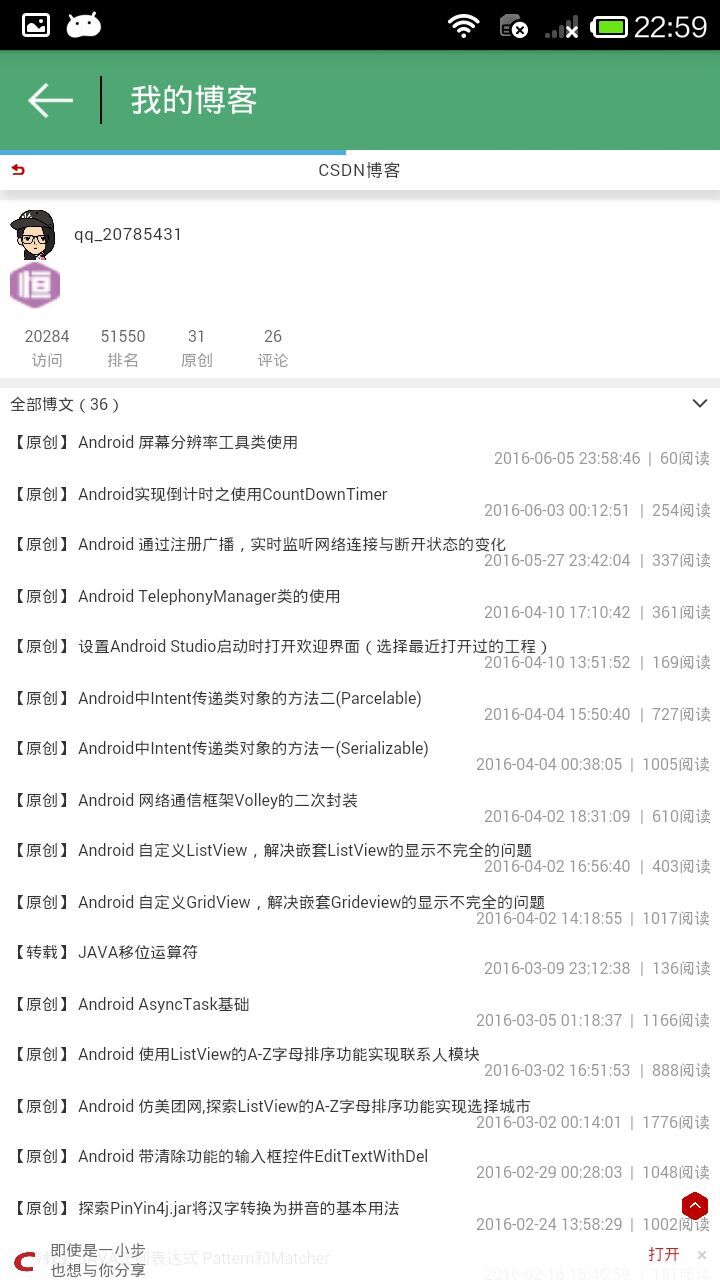Adnroid 打造通用的帶進度條的WebView
阿新 • • 發佈:2019-02-17
在Android開發中,經常需要載入顯示網頁,一般一個頁面在開啟後,在等待資料載入的過程中,都需要花一點時間,這個時候往往需要顯示一個轉動的進度條(ProgressBar),接下來封裝了一個自定義控制元件和載入網頁的公共Activity,方便使用。
一般的做法是在layout.xml中新增ProgressBar,但我們不這樣做,主要是為了減少layout巢狀。
按照慣例我們先來看看最終的效果圖:

在呼叫的時候很簡單,就只需要傳遞一個url(載入網頁的url)和title(顯示標題)就可以了,如下所示:
Intent intent = new Intent(MainActivity.this 1.接下來主要還是看看重寫的帶載入條的webview
package com.per.loadingwebviewdome;
import android.content.Context;
import android.os.Environment;
import 我們重寫了3個構造方法,預設的佈局檔案呼叫的是兩個引數的構造方法,所以記得讓所有的構造呼叫我們的三個引數的構造,我們在三個引數的構造中獲得自定義View的屬性。
然後在佈局中宣告我們的自定義View
<?xml version="1.0" encoding="utf-8"?>
<LinearLayout xmlns:android="http://schemas.android.com/apk/res/android"
android:layout_width="match_parent"
android:layout_height="match_parent"
android:orientation="vertical">
<include layout="@layout/common_top_banner" />
<com.per.loadingwebviewdome.LoadingWebView
android:id="@+id/wv_loading"
android:layout_width="match_parent"
android:layout_height="match_parent" />
</LinearLayout>2.下面就是通用的帶進度條的WebView啦
package com.per.loadingwebviewdome;
import android.app.Activity;
import android.os.Bundle;
import android.view.View;
import android.widget.ImageView;
import android.widget.TextView;
/**
* @author: xiaolijuan
* @description: 通用的帶進度條的WebView
* @date: 2016-06-03
* @time: 23:32
*/
public class MainWebViewActivity extends Activity implements View.OnClickListener {
private ImageView mIvBack;
private TextView mTvTitle;
private LoadingWebView mLoadingWebView;
private String mTitle = "";
private String mUrl = "";
@Override
protected void onCreate(Bundle savedInstanceState) {
super.onCreate(savedInstanceState);
setContentView(R.layout.activity_webview);
initView();
initData();
}
private void initView() {
mIvBack = (ImageView) findViewById(R.id.iv_back);
mLoadingWebView = (LoadingWebView) findViewById(R.id.wv_loading);
mTvTitle = (TextView) findViewById(R.id.tv_title);
mLoadingWebView.addProgressBar();
mIvBack.setOnClickListener(this);
}
private void initData() {
mTitle = getIntent().getStringExtra("title");
mUrl = getIntent().getStringExtra("url");
mLoadingWebView.loadMessageUrl(mUrl);
mTvTitle.setText(mTitle);
}
@Override
public void onDestroy() {
super.onDestroy();
mLoadingWebView.destroyWebView();
}
@Override
public void onClick(View v) {
switch (v.getId()) {
case R.id.iv_back:
if (mLoadingWebView.canGoBack())
mLoadingWebView.goBack();
else {
finish();
}
break;
}
}
/**
* 按返回鍵時, 不退出程式而是返回WebView的上一頁面
*/
@Override
public void onBackPressed() {
if (mLoadingWebView.canGoBack())
mLoadingWebView.goBack();
else {
super.onBackPressed();
}
}
}
